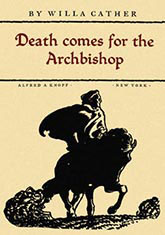Death Comes for the Archbishop
Critique • Quotes
 First edition
First editionFirst publication
1927
Literature form
Novel
Genres
Literary, historical fiction
Writing language
English
Author's country
United States
Length
Approx. 73,000 words
Strangers in their own land
Death Comes for the Archbishop is often considered Willa Cather's masterpiece and is on several lists as one of the greatest novels of the twentieth century—which may be surprising if you read it alongside other American literature that came out around the same time.
Fitzgerald's The Great Gatsby and Dreiser's An American Tragedy had been published just two years earlier, followed by Hemingway's The Sun Also Rises and Sinclair Lewis's Elmer Gantry. Along with other excitingly modern, jaded novels of social criticism of the 1920s. Even harder hitting works were to come as the so-called Roaring Twenties were replaced by the Dirty Thirties.
And in the midst of this, Willa Cather was penning a meandering meditation on the life of a couple of good-natured French priests, missionaries really, among the Indians, Mexicans and Spanish settlers of the American southwest in the mid-1800s.
Death Comes for the Archbishop seems out of place in the overall sweep of modern literature. Its writing style is relaxed and its story, as much as there is one, hearkens back to a period of quiet, individual heroism far from the dire social problems of contemporary life. Worse, it borders on being religious.
Anti-colonial twist
One wants to say in Cather's defence she is taking up issues of more universal significance—matters of conscience and individual morality in the struggles to survive in a harsh world, struggles that defined North America early on and have shaped the society that emerged from them. And there is a subtle anti-colonial twist.
Fathers Latour and Vaillant, whose names obviously suggest their respective proclivities of scholarly reflection and bold action, don't actually save many souls in the New World. They may set out to bring Roman Catholicism to this less civilized area, but their biggest breakthroughs come when they accept the pagan traditions and uncomplicated goodness of their purported flock. For all they accomplish, it is they who are spiritually saved in ways they could not have been if they had remained clerics in comfortable European postings.
However, this interpretation may seem cobbled together in desperation, based on too little data submitted by the author.
This novel is really a collection of episodes taken from the experiences of the priests—mainly Latour—over their entire adult lives. Most of the stories are rivetting accounts of facing daunting challenges presented by the country, the people, and other religious figures. Highlights include Latour's first solitary ride through the hostile territory to seek his assigned diocese, Vaillant's near-mystical experience in a cave of pagan religious significance, the two priests' escape from an American murderer, and several struggles against gluttonous padres who exploit their trusting parishioners.
Cather's writing is as always wonderful to read, especially as she connects the characters and the environment. She had achieved this in earlier works, like O Pioneers! and My Ántonia, taking place in the American Midwest where she grew up—but accomplishing it now in this very different territory of canyons, mesas, cliffs and deserts is something of a writing miracle. The trick is to show the people adapting to the land both physically and mentally, to bring out its beauty without giving up a bit of its unforgiving, alien character. No one does it better.
But in Death Comes for the Archbishop this makes for great short stories rather than a great novel. There appears to be no sweeping drama, no romance, no overarching relationship conflicts to sort out. Mainly, the priest Latour, who successively becomes bishop and archbishop in the far-flung diocese of New Mexico, reflects on the large and small challenges he's faced and how he has changed. But even this is pallid. Experiences occur, are gladdening or saddening, and everything generally works out for the best, presumably according to some mysterious, unseen plan.
Large tracts of time pass and we're soon near the end of Latour's existence without really feeling close to him.
Rugged Americana
The book's title suggests perhaps the priest's whole story is about rising to the top clerical ranks or about preparing for the end of his time on earth. Yet there is little evidence of this throughout the novel. Only toward the end does Cather fill in some of the earliest relevant detail about Latour's life and his relationship with Vaillant, and this appears tacked on to make their deaths more poignant than they would otherwise be for the reader.
So. interesting book, some great writing. But not one of the greatest novels of the twentieth century. Probably not one of the greatest novels of the 1920s.
I suspect the spiritual aspects and the rugged Americana have raised the novel higher in the canon than it deserves.
Still, you've got to appreciate everything Cather does. And parts of Death Comes for the Archbishop are among her most accomplished writing. Maybe not her masterpiece, as often acclaimed, but worth reading.
The world and times visited may stay with you long after the journey's over.
— Eric
Critique • Quotes

